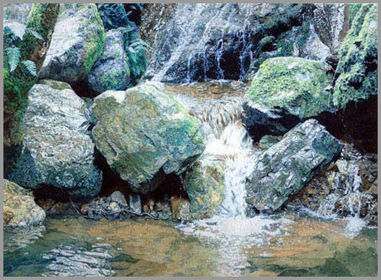MY PAINTING PROCESS
by Will Noble
People are often confused by my process. First, they may think the painting is a photograph, perhaps digitally manipulated. Then, when told it is a painting, they assume that I have painted over a photograph or worked from a projected image. I assure you none of this is the case. It is important to me to paint what I see, and the more I look, the more detail I see. As crazy as it may seem to others, I spend hundreds of hours in stillness with just my pencil in hand, my eyes peering through a magnifying glass hovering over a photograph I have taken. This process of seeing-drawing-painting is an intrinsic part of my life. You might think of it as meditation.





Step One - In the Wild
Because of the complexity of my work, (and because my subject matter is usually found in cold damp places) I work from photographs that I have taken throughout Marin County and the Sierra. I look for interesting movements of water, interactions of water with rock, light, and vegetation. I am always out with my camera after a good winter rainstorm.
Step Two - Into the Studio
In the studio I start sketching and composing with a blue Col-erase pencil on 140lb or 300lb hot press watercolor paper, depending on the size of the piece.
After I am satisfied with the subject and composition, I begin detailing the work, using a magnifying glass to clarify otherwise hidden patterns in the photograph. I start the drawing from one side top to bottom, keeping the rest of the paper covered so as not to smear my original layout.
Step Three - Detailed Drawing Completed
Depending on the size and complexity of the work, the drawing alone can take up to 450 hours.For me it is a daily meditation. There is no timeline or pressure to finish. I am fully in the moment with the experience. I have been told that the finished work evokes a sense of being fully present for the viewer after spending time with the piece.
On occasion, as with Peggy's Pond, I choose to leave it as a drawing rather than paint it. But in most cases, I continue on.
Step Four - Painting Begins
When the drawing is complete, I begin with light watercolor washes over the blue pencil. Col-erase blue is water-soluble so I compensate when I mix my colors. I build up value by layering one wash over another, a sort of glazing technique carried over from traditional oil painting.
This example is a watercolor but the process is the same with oil paints, except instead of drawing with a pencil I 'draw' with a brush and burnt sienna paint.
Finished Painting
This piece is titled Indian Valley Creek.
For more information or to see the works in person, please contact me.
- Will Noble